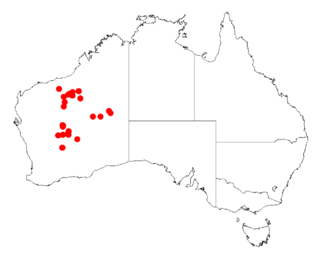
Acacia xiphophylla, commonly known as snakewood or snake-wood, is a tree in the family Fabaceae that is endemic to Western Australia. The indigenous group the Martuthunira, Ngarluma and Yindjibarndi peoples know it as marrawa, the Kariyarra know it as puluru and the Jiwarli know it as pukarti.

Acacia arcuatilis is a shrub belonging to the genus Acacia and the subgenus Juliflorae that is endemic to south western parts of Australia.

Acacia gibbosa is a shrub or tree belonging to the genus Acacia and the subgenus Juliflorae native to Western Australia.

Acacia isoneura is a shrub belonging to the genus Acacia and the subgenus Juliflorae that is endemic to western Australia.

Acacia merinthophora, also known as zig-zag wattle, is a tree or shrub belonging to the genus Acacia and the subgenus Juliflorae that is endemic to western Australia.

Acacia trachycarpa, commonly known as minni ritchi, curly-bark tree, sweet-scented minni ritchi or Pilbara minni ritchi, is a shrub or tree belonging to the genus Acacia and the subgenus Juliflorae that is native to arid and semi-arid areas of Western Australia.

Acacia aestivalis is a shrub belonging to the genus Acacia and the subgenus Phyllodineae that is native to Western Australia.

Acacia forrestiana, commonly known as Forrest's wattle, is a shrub belonging to the genus Acacia and the subgenus Phyllodineae that is native to Western Australia. The species was listed as vulnerable by the Environment Protection and Biodiversity Conservation Act 1999 in 2008.

Acacia inamabilis is a shrub belonging to the genus Acacia and the subgenus Phyllodineae that is native to Western Australia.

Acacia pulviniformis is a shrub of the genus Acacia and the subgenus Phyllodineae that is endemic to south western Australia.

Acacia saxatilis is a shrub of the genus Acacia and the subgenus Phyllodineae that is endemic to south western Australia

Acacia sericocarpa is a shrub of the genus Acacia and the subgenus Phyllodineae that is endemic to south western Australia.

Acacia anfractuosa is a shrub or tree of the genus Acacia and the subgenus Plurinerves that is endemic to Western Australia.

Acacia balsamea, commonly known as balsam wattle, is a shrub of the genus Acacia and the subgenus Plurinerves.

Acacia dissona is a shrub of the genus Acacia and the subgenus Plurinerves that is endemic to an area of south western Australia.

Acacia nivea is a shrub of the genus Acacia and the subgenus Plurinerves that is endemic to south western Australia.
Acacia papulosa is a shrub of the genus Acacia and the subgenus Plurinerves that is endemic to a small area along the south coast of south western Australia.
Acacia prismifolia is a shrub of the genus Acacia and the subgenus Plurinerves that is endemic to a small area of south western Australia. It was once thought to be extinct until a specimen was found in 2018.

Acacia undosa is a shrub of the genus Acacia and the subgenus Plurinerves that is endemic to an area of south western Australia.
Acacia rigida is a shrub belonging to the genus Acacia and the subgenus Phyllodineae that is native to parts of western Australia.

















